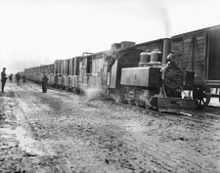|
War Department Light RailwaysThe War Department Light Railways were a system of narrow gauge trench railways run by the British War Department in World War I. Light railways made an important contribution to the Allied war effort in the First World War, and were used for the supply of ammunition and stores, the transport of troops and the evacuation of the wounded. Track gaugesDifferent track gauges were used in different parts of the world including 600mm, 760 mm (2 ft 5+15⁄16 in), 1,000 mm (3 ft 3+3⁄8 in) metre gauge and 1,050 mm (3 ft 5+11⁄32 in). The military light railways in France were of 600 mm (1 ft 11+5⁄8 in) gauge and used a variety of steam and petrol locomotives from French, British and American builders. The Germans installed their 600 mm (1 ft 11+5⁄8 in) gauge Feldbahn system early in the war. Trench railways of the World War I western front produced the greatest concentration of minimum-gauge railway locomotives observed to date.[1] Development Britain came to the belated realisation that it needed a flexible and reliable method of supplying the front lines, bringing shells, timber, and fodder from the rear areas and their standard gauge supply points. Narrow gauge light railways were the solution. Hundreds of locomotives were built by companies such as Hunslet, Kerr Stuart, ALCO, Davenport, Motor Rail and Baldwin to work these lines. Also, Model T Ford conversions were used. Thirty or so Companies were formed within the Royal Engineers to staff the lines. These were mostly British ex-railwaymen pressed into service, though Australian, South African and Canadian gangs served with distinction. An American unit also served under the British flag. Each area of the front would have its own light rail to bring up materiel. The British perfected roll on roll off train ferries[2][page needed] to bring fodder and supplies direct from England via train ferries to France. Northern French rail lines were under direct military control of the Army in the area. By 1917, the Canadians led the way in showing the utility of light railways. Having built thousands of miles of new frontier track in Western Canada in the previous decades, these "colonials", led by J. Stewart, supplied the Canadian Corps who went on to victory at Vimy. From this the light railways were expanded to 700 miles (1,100 km) of track, which supplied 7,000 tons of supplies daily. The ebb and flow of war meant that rail lines were built and rebuilt, moved and used elsewhere, but by the latter years of Passchendaele, Amiens and Argonne, light railways came into their own and pulled for the final victory. WDLR locomotivesA large number of locomotives[3] (mostly of 600 mm (1 ft 11+5⁄8 in) gauge) was ordered for the WDLR. These included: Steam 
Internal combustion 
CapturedA few captured German feldbahn locomotives were also used but these usually had short lives because no spare parts were available for them. Other locomotivesBoth the French Army and the U.S. Army had their own locomotives, which included: French Army
U.S. ArmyPreserved locomotivesBaldwin Probably the most famous of these war service engines were of class 10-12-D, built by the Baldwin Locomotive Works, U.S. Nearly 500 were built and those that survived the war found new homes around the world. Many went to India and after the war a few went to railways in Britain including:
Four of this type of locomotive have been repatriated from India and preserved in the UK, two in full working order, and the other two undergoing restoration in 2021. HunsletHunslet 4-6-0 Locomotive no. 1215 of 1916, was repatriated from Australia in 2008 where she had worked since 1924 on the sugar cane railways of Queensland, before ending up at Rowan Bay Bush Children's Home in a playground around 1962. She is currently in full working order at the Moseley Railway Trust's Apedale Valley Light Railway, Newcastle-under-Lyme, Staffordshire, United Kingdom. Hunslet 4-6-0 Locomotive no. 1218 of 1916, formerly of Gin Gin Mill, is currently with D.Revell, Weewaa, New South Wales, Australia.[6] This is the locomotive which is now preserved at the Australian War Memorial, Canberra, Australia, although she may be in store and not on public display. Hunslet 4-6-0 Locomotive no. 1229 of 1916, formerly of Cattle Creek Mill, is currently stored at ANGRMS, Woodford QLD, Australia. Awaiting restoration.[7] Hunslet 4-6-0 Locomotive no. 1239 of 1916, retrieved from a public park in Mackay, restored at the Rail Workshops Museum, currently on display at the Rail Workshops Museum, North Ipswich, Queensland, Australia [8] The Motor Rail & Tramcar Co Ltd,Surplus Motor Rail internal combustion locomotives were sold off after the war and provided service for decades in industrial narrow gauge railways systems, such as the Leighton Buzzard Light Railway. The larger (40HP) locomotives came in 'open', 'protected', and 'armoured' versions resulting in the curious spectacle of fully armoured locomotives appearing in an industrial context. Many locomotives were overhauled and/or modified by Kent Construction & Engineering Co. Ltd of Ashford which can complicate identifying locomotives (for example "Mary Ann" - the Ffestiniog Loco).
See also
References
Sources
Further reading
|